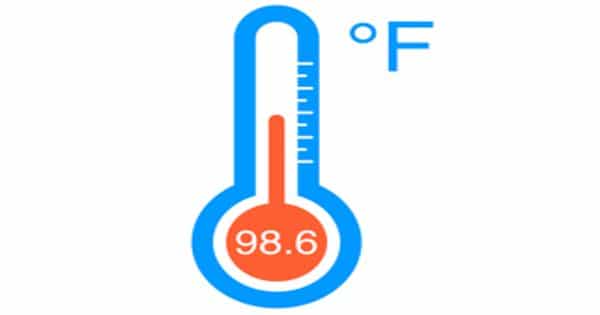A drop in body temperature
Body temperature is a measure of your body’s ability to make and get rid of heat. Researchers examine the decline in average body temperature among healthy adults over the past two decades. The body is very good at keeping its temperature within a safe range, even when temperatures outside the body change a lot.
If a low body temperature is your only symptom, it is not something to worry about. If a low body temperature occurs with other symptoms, such as chills, shaking, breathing problems, or confusion, then this may be a sign of more serious illness. Heatstroke occurs when the body fails to control its own temperature and body temperature keeps rising.
In the nearly two centuries since German physician Carl Wunderlich established 98.6°F as the standard “normal” body temperature, it has been used by parents and doctors alike as the measure by which fevers – and often the severity of illness – have been assessed. Body temperature below 95°F (35°C) is considered abnormally low, and the condition is known as hypothermia. This happens when your body loses heat faster than it can produce heat.
“The researchers were initially surprised to find no single “magic bullet” that could explain the decline in body temperature. “It’s likely a combination of factors — all pointing to improved conditions,” Gurven said.”
The normal body temperature can be anywhere between 97°F (36.1°C) and 99°F (37.2°C) in different individuals. Over time, however, and in more recent years, lower body temperatures have been widely reported in healthy adults. A 2017 study among 35,000 adults in the United Kingdom found average body temperature to be lower (97.9°F), and a 2019 study showed that the normal body temperature in Americans (those in Palo Alto, California, anyway) is about 97.5°F. Low body temperature (hypothermia) occurs when heat loss from the body is higher than heat produced in the body. It is most commonly caused by exposure to cold-weather conditions or cold water.
A multinational team of physicians, anthropologists, and local researchers led by Michael Gurven, UC Santa Barbara professor of anthropology and chair of the campus’s Integrative Anthropological Sciences Unit, and Thomas Kraft, a postdoctoral researcher in the same department, have found a similar decrease among the Tsimane, an indigenous population of forager-horticulturists in the Bolivian Amazon.
The anthropologists’ research appears in the journal Sciences Advances.
“The provocative study showing declines in normal body temperature in the U.S. since the time of the Civil War was conducted in a single population and couldn’t explain why the decline happened,” said Gurven. “But it was clear that something about human physiology could have changed. One leading hypothesis is that we’ve experienced fewer infections over time due to improved hygiene, clean water, vaccinations and medical treatment. In our study, we were able to test that idea directly. We have information on clinical diagnoses and biomarkers of infection and inflammation at the time each patient was seen.
While some infections were associated with higher body temperature, adjusting for these did not account for the steep decline in body temperature over time, Gurven noted. “And we used the same type of thermometer for most of the study, so it’s not due to changes in instrumentation,” he said.
Added Kraft, “No matter how we did the analysis, the decline was still there. Even when we restricted analysis to the <10% of adults who were diagnosed by physicians as completely healthy, we still observed the same decline in body temperature over time.”
It could be that people are in better condition, so their bodies might be working less to fight infection, he continued. Or greater access to antibiotics and other treatments means the duration of infection is shorter now than in the past. Consistent with that argument, Gurven said, “We found that having a respiratory infection in the early period of the study led to having a higher body temperature than having the same respiratory infection more recently.”
“Another possibility is that our bodies don’t have to work as hard to regulate internal temperature because of air conditioning in the summer and heating in the winter,” Kraft said. “While Tsimane body temperatures do change with time of year and weather patterns, the Tsimane still do not use any advanced technology for helping to regulate their body temperature. They do, however, have more access to clothes and blankets.”
The researchers were initially surprised to find no single “magic bullet” that could explain the decline in body temperature. “It’s likely a combination of factors — all pointing to improved conditions,” Gurven said.
According to Gurven, the finding of lower-than-expected body temperatures in the U.S., and the decline over time, had a lot of people scratching their heads. Was it a fluke? In this study, Gurven and his team confirm that body temperatures below 98.6°F are found in places outside the U.S. and the U.K.
As a vital sign, temperature is an indicator of what’s occurring physiologically in the body, much like a metabolic thermostat. “One thing we’ve known for a while is that there is no universal ‘normal’ body temperature for everyone at all times, so I doubt our findings will affect how clinicians use body temperature readings in practice” said Gurven. Despite the fixation on 98.6°F, most clinicians recognize that ‘normal’ temperatures have a range. Throughout the day, body temperature can vary by as much as 1°F, from its lowest in the early morning, to its highest in the late afternoon. It also varies across the menstrual cycle and following physical activity and tends to decrease as we age
Your body’s like a little furnace. It puts out heat all the time. It comes from your body doing the work that keeps you alive. When it puts out a lot more or a lot less heat than usual, it’s trying to tell you there’s a problem.
















